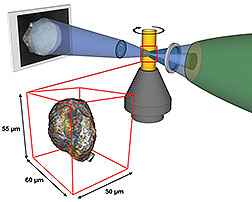- Number 439 |
- May 18, 2015
Researchers study how metal contamination makes gasoline production inefficient

Research at the Department of Energy’s
SLAC National Accelerator Laboratory could
lead to more efficient gasoline production.
(@iStockphoto/Patryk Kosmider)
Scientists at the DOE’s SLAC National Accelerator Laboratory and Utrecht University have identified key mechanisms of the aging process of catalyst particles that are used to refine crude oil into gasoline. This advance could lead to more efficient gasoline production.
Their recent experiments studied so-called fluid catalytic cracking (FCC) particles that are used to break long-chain hydrocarbons in crude oil into smaller, more valuable hydrocarbons like gasoline.
“A major problem is that these catalysts quickly age and lose their activity, so tons of fresh catalysts have to be added to a reactor system every day,” said lead researcher Florian Meirer, assistant professor of inorganic chemistry and catalysis at Utrecht University in the Netherlands. “We are trying to understand how this aging happens, and we’re working with companies that produce these FCC catalysts to make the process more efficient.”
In experiments using X-ray beams at SLAC’s Stanford Synchrotron Radiation Lightsource (SSRL), a DOE Office of Science User Facility, the researchers studied FCC catalysts of various ages to better understand the effects of aging. They were able to image whole catalyst particles with high resolution so they could also see the catalysts’ internal structure – like taking a panoramic landscape photograph where you can zoom in to see the ants.
“We have been able to localize the metal poisons that are a leading cause of catalyst aging and also determine how they influence the materials,” said Bert Weckhuysen, professor of inorganic chemistry and catalysis at Utrecht University. “It’s been studied in the past, but not at this resolution and not on the single particle level. That is the beauty of what we have done.”
Casting Light on Metals
The problem of catalyst aging is widespread and costly. Worldwide, about 400 reactor systems refine crude oil into gasoline, and each system requires 10 to 40 tons of fresh FCC catalysts daily.

SSRL X-rays are focused to illuminate a
small sample of catalysts inside a movable
cylindrical holder. A lens magnifies the
resulting sample image onto a screen, a
CCD camera captures the 2-D image, and
software is used to reconstruct a 3-D image
of the single catalyst particle from a series
of these 2-D images.
(Florian Meirer/Utrecht University)
Crude oil is contaminated with metals, mostly iron, nickel and vanadium. These metals accumulate in catalysts during refining and eventually deactivate them. This is particularly an issue for low-quality crude oil, the largest available oil supply.
“Cheaper oil is often more polluted with metal poisons,” said Weckhuysen. “If we want to use cheap oil as feedstock, then we have to improve FCC catalysts to make them more resistant against metal poisons.”
In the SSRL study, the research team took a series of two-dimensional images of catalyst particles at various angles and used software they developed to combine them into three-dimensional images of whole particles. These images show the 3-D distribution of iron and nickel in catalysts of various ages.
“This ‘mosaic imaging’ technique is a major reason why we do our experiments at the SSRL,” Meirer said.
Designing Better 'Catalyst Highways'
The researchers determined that the metals quickly accumulate on the outer surface of a catalyst, blocking the crude oil molecules from traveling through catalyst pores to reach deeper into its still-active core. They also showed that some catalyst particles stick together in clusters, which disturbs the fluidity of the catalysts and lowers gasoline production yields.
The Utrecht researchers are already working with companies to redesign these FCC catalysts.
“All of our conclusions are about the macropores, which are like highways for crude oil traveling through the catalysts. It’s about blockage along Highway 101 or 280, not small streets in San Francisco,” explained Weckhuysen. “Can we design better catalyst pores or highways?”
The research team also included Sam Kalirai at Utrecht and Darius Morris, Yijin Liu and Joy C. Andrews at SSRL. This research was supported by the NWO Gravitation program, Netherlands Center for Multiscale Catalytic Energy Conversion, Netherlands Research School Combination-Catalysis and a European Research Council Advanced Grant.
Video: https://www.youtube.com/watch?v=fX_pkU6GI3w
Reconstructed 3-D image of a single catalyst particle, showing where iron (orange) and nickel (blue) deposited on the surface and inside the catalyst. The movie shows a rotating particle to view the entire catalyst surface, and then cross sectional slices to see inside the catalyst. (Florian Meirer/Utrecht University)Story on SLAC website: https://www6.slac.stanford.edu/news/2015-04-30-researchers-study-how-metal-contamination-makes-gasoline-production-inefficient.aspx
[Angela Anderson, 650.926.3505,
angelaa@slac.stanford.edu]
